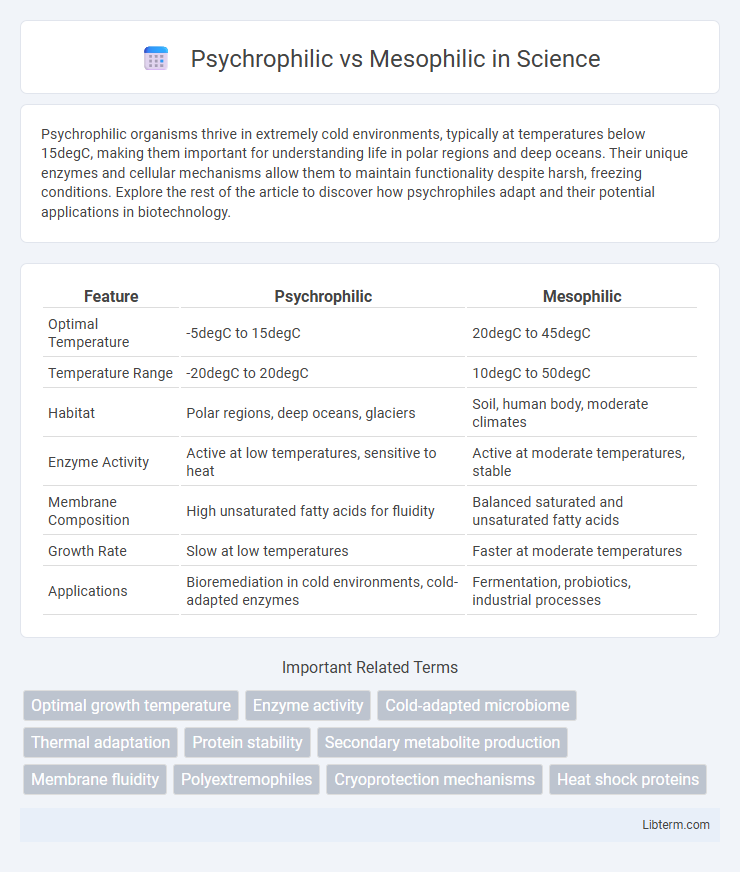Psychrophilic organisms thrive in extremely cold environments, typically at temperatures below 15degC, making them important for understanding life in polar regions and deep oceans. Their unique enzymes and cellular mechanisms allow them to maintain functionality despite harsh, freezing conditions. Explore the rest of the article to discover how psychrophiles adapt and their potential applications in biotechnology.
Table of Comparison
| Feature | Psychrophilic | Mesophilic |
|---|---|---|
| Optimal Temperature | -5degC to 15degC | 20degC to 45degC |
| Temperature Range | -20degC to 20degC | 10degC to 50degC |
| Habitat | Polar regions, deep oceans, glaciers | Soil, human body, moderate climates |
| Enzyme Activity | Active at low temperatures, sensitive to heat | Active at moderate temperatures, stable |
| Membrane Composition | High unsaturated fatty acids for fluidity | Balanced saturated and unsaturated fatty acids |
| Growth Rate | Slow at low temperatures | Faster at moderate temperatures |
| Applications | Bioremediation in cold environments, cold-adapted enzymes | Fermentation, probiotics, industrial processes |
Introduction to Psychrophilic and Mesophilic Organisms
Psychrophilic organisms thrive in temperatures ranging from -20degC to 10degC, exhibiting adaptations that allow cellular function in extreme cold environments such as polar regions and deep oceans. Mesophilic organisms prefer moderate temperatures between 20degC and 45degC, commonly found in soil, water, and the human body, where they play crucial roles in decomposition and health. Both types have distinct enzyme systems optimized for their respective temperature ranges, influencing their metabolic activities and ecological niches.
Defining Psychrophiles: Characteristics and Adaptations
Psychrophiles are microorganisms that thrive in extremely cold environments, typically below 15degC, with optimal growth around 0-10degC. They possess unique adaptations such as flexible cellular membranes rich in unsaturated fatty acids and specialized cold-active enzymes that maintain metabolic functions at low temperatures. These traits enable psychrophiles to sustain life in polar regions, deep oceans, and permafrost, contrasting mesophiles that favor moderate temperatures between 20-45degC.
Understanding Mesophiles: Key Features and Functions
Mesophiles thrive at moderate temperatures, typically between 20degC and 45degC, making them crucial in natural ecosystems and industrial processes such as fermentation and bioremediation. These microorganisms exhibit optimal enzyme activity within this range, enabling efficient metabolic functions essential for nutrient cycling and organic matter decomposition. Their adaptability to varied environments positions mesophiles as pivotal agents in pharmaceuticals, agriculture, and wastewater treatment applications.
Optimal Temperature Ranges for Psychrophiles and Mesophiles
Psychrophiles thrive in optimal temperature ranges between -20degC and 10degC, exhibiting metabolic activity and growth in cold environments such as polar regions and deep ocean waters. Mesophiles prefer moderate temperatures, typically growing best between 20degC and 45degC, common in soils, human bodies, and temperate habitats. These distinct temperature preferences influence enzymatic functions and membrane fluidity, enabling psychrophiles to survive extreme cold while mesophiles dominate more moderate ecological niches.
Environmental Habitats: Where Psychrophiles and Mesophiles Thrive
Psychrophiles thrive in extremely cold environments such as polar regions, deep ocean waters, and glaciers where temperatures often fall below 15degC, adapting to subzero habitats by producing specialized enzymes and antifreeze proteins. Mesophiles inhabit moderate temperature environments ranging from 20degC to 45degC, including soil, freshwater, and the human body, making them predominant in agricultural soils and warm-blooded animal microbiomes. The contrasting habitat preferences of psychrophiles and mesophiles reflect their evolutionary adaptations to temperature, influencing microbial diversity in ecosystems from tundra soils to tropical forests.
Cellular and Molecular Adaptations to Temperature
Psychrophilic organisms exhibit cellular adaptations such as increased membrane fluidity through higher unsaturated fatty acid content, facilitating enzyme function and nutrient transport at low temperatures. Mesophilic organisms maintain optimal cellular function at moderate temperatures via balanced membrane lipid composition and thermostable enzymes with stable tertiary structures. Molecular adaptations in psychrophiles include cold-active enzymes with flexible active sites and reduced activation energy, while mesophiles rely on enzymes optimized for moderate thermal stability and catalytic efficiency.
Metabolic Differences: Energy Production Strategies
Psychrophilic organisms utilize specialized enzymes adapted for low-temperature environments to maintain efficient energy production through slow but steady metabolic pathways, primarily relying on oxidative phosphorylation and psychrophilic-specific variants of electron transport chains. Mesophilic organisms exhibit optimal metabolic rates at moderate temperatures, employing more versatile and robust energy production strategies, including glycolysis and the tricarboxylic acid cycle, enabling faster ATP generation. The temperature-dependent enzyme kinetics in psychrophiles and mesophiles directly influence their cellular respiration efficiency, impacting their growth and survival in distinct thermal niches.
Applications in Biotechnology and Industry
Psychrophilic microorganisms thrive at temperatures below 15degC and are utilized in biotechnology for cold-active enzyme production, which is essential in industries such as food processing and bioremediation in cold environments. Mesophilic organisms, optimal at 20-45degC, are widely used in fermentation processes, waste treatment, and the production of antibiotics and biofuels due to their robust metabolic activity at moderate temperatures. The application of psychrophiles enables energy-efficient industrial processes by reducing heating costs, while mesophiles offer higher growth rates and stability for large-scale biotechnological operations.
Challenges and Limitations in Studying Psychrophiles and Mesophiles
Studying psychrophilic microorganisms presents challenges due to their strict adaptation to cold environments, requiring specialized low-temperature cultivation and lengthy incubation periods that limit experimental throughput. Mesophiles, thriving at moderate temperatures, are easier to culture but often overshadow psychrophiles, creating gaps in comparative research that assess metabolic and enzymatic adaptations across temperature ranges. Both groups face limitations in laboratory simulation of natural habitats, affecting the accuracy of ecological and physiological studies essential for understanding microbial roles in climate-sensitive ecosystems.
Future Prospects in Psychrophilic and Mesophilic Research
Psychrophilic and mesophilic microorganisms offer promising future prospects in biotechnology, with psychrophilic enzymes enabling advancements in biocatalysis under cold conditions, enhancing energy efficiency and reducing environmental impact. Research into mesophilic organisms continues to drive improvements in industrial fermentation processes and bioremediation, leveraging their optimal growth at moderate temperatures for scalable production. Innovations in genomic and proteomic technologies are accelerating the discovery of novel psychrophilic and mesophilic strains, unlocking potential applications in pharmaceuticals, agriculture, and environmental sustainability.
Psychrophilic Infographic

 libterm.com
libterm.com